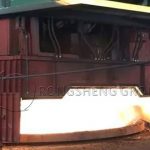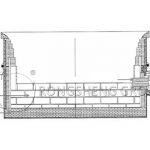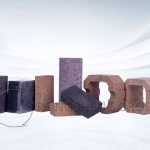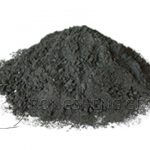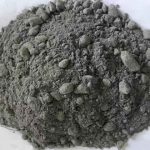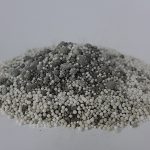The submerged arc furnace is a complex metallurgical equipment system, and its service time mainly depends on the life of the furnace lining. Before the submerged arc furnace was enlarged, due to the small amount of furnace lining refractory materials and the low cost of building the furnace, the ferroalloy industry did not pay enough attention to the furnace lining life. As submerged arc furnaces develop towards larger sizes, the cost of furnace lining shutdown, repair, or re-lining increases significantly. Therefore, how to obtain a long-life submerged arc furnace lining has become particularly important.
Large-scale submersible arc furnaces have the advantages of higher thermal efficiency, higher output, lower unit power consumption, and more stable operation. They are also conducive to the purification and recovery of smoke and dust and the utilization of waste heat. According to actual production experience, it is found that the main reasons for submerged arc furnace lining damage include: improper selection of refractory materials, unreasonable furnace lining structural design, quality problems in furnace construction, and irregular production operations. Among them, quality problems in furnace construction and irregular production operations can be avoided through institutionalization and standardization. Therefore, the correct selection of refractory materials and reasonable design of the furnace lining structure are important guarantees for the long-life operation of the submerged arc furnace lining. Combining the research results and industrial use of submerged arc furnace linings at home and abroad in recent years, the damage mechanism of the furnace lining was understood and the basis for selecting refractory materials for the furnace lining was clarified.
![]()
Damage Mechanism of Submerged Arc Furnace Lining Refractory Materials
The submerged arc furnace uses three self-baking electrodes to heat the charge, reduce the metal elements from the oxide ore and smelt them. The temperature in the furnace can reach a maximum of 2000~3000℃. The lining of submerged arc furnace is generally composed of three parts: outer layer, middle layer and inner layer. The outer layer is used for thermal insulation and is rarely damaged. It is called the permanent layer. The middle layer plays the role of preventing furnace leakage and is relatively safe. It is also called the safety layer. The inner layer is also called the working layer. The refractory material in this layer has the worst working conditions and is the most vulnerable part of the furnace lining. Therefore, the damage to the furnace lining is mainly the damage to the refractory material of the working layer. The reasons include physical, chemical, mechanical and other factors. details as follows:
(1) Corrosion effect. When the working temperature of the refractory material in the working layer exceeds its refractoriness, corrosion will occur. The load softening temperature of magnesia furnace lining is about 1550℃. Corrosion is most likely to occur in higher temperature locations such as the furnace wall near the arc zone and the furnace bottom below the self-baking electrode.
(2) Chemical attack. The refractory material of the working layer may react chemically with slag, molten metal, reaction atmosphere, etc. The furnace environment is different during the smelting process of different ferroalloys, and the chemical reactions that occur are also different. The most commonly used carbonaceous furnace lining for submersible arc furnaces will undergo oxidation reactions when temperatures exceed 400°C, and may even cause “reverse oxidation”, causing internal cavitation and material damage. Carbon-deficient operations during smelting also consume carbonaceous materials as reducing agents. The service temperature of magnesia furnace lining is often higher than its load softening temperature. When it is in the reflow state, it will accelerate the chemical erosion of slag and molten alloy.
(3) Mechanical erosion. The refractory material of the working layer will be subject to mechanical effects such as the impact of pouring metallurgical raw materials, erosion of metal melt and slag. The strength of refractory materials in areas with higher operating temperatures will be reduced or even softened to varying degrees. More susceptible to damage when subjected to mechanical action.
Selection of Refractory Materials for Submersible Furnace Lining
There are many types of ferroalloys. Different ferroalloys have different working temperatures during smelting, and the properties of the metal melt and slag in the furnace are different. Therefore, the selection of furnace lining refractory materials also varies. The most critical thing in furnace lining is the working layer, and material selection is the most important. Selection of furnace lining refractory materials for different ferroalloy production. Under normal circumstances, the smelting temperature of metal silicon, ferrosilicon, calcium carbide and silicon-chromium alloy is relatively high, and the working layer needs to use carbonaceous furnace lining. The slag generated by high-carbon ferromanganese and manganese-silicon alloy is acidic, and carbonaceous furnace linings are often used. The slag of low-carbon ferromanganese and medium-low-carbon ferrochromium is alkaline, so magnesia furnace linings are generally used.
In the same submerged arc furnace, the working environments of furnace walls and furnace bottoms of different heights are quite different, and their damage mechanisms and damage speeds are different. Therefore, it is necessary to select refractory materials with different physical and chemical properties. Usually the furnace wall near the slag line and under the furnace bottom electrode is damaged quickly. In particular, the taphole is the most vulnerable part of the furnace lining structure, and the material selection at these locations is the most critical. Taking ferrochromium alloy as an example, the furnace wall uses carbonaceous and alumina materials, the furnace bottom uses carbonaceous and magnesia materials, and the tap hole uses carbonaceous and silicon carbide materials.
The normal service life of the submerged arc furnace lining can reach 10 years or even longer. However, taphole eye bricks often fail prematurely in less than a year. Current research shows that short-term damage to submerged arc furnaces is mainly caused by local damage to the taphole. When the submerged arc furnace discharges slag and metal melt outwards, it will cause mechanical erosion, chemical erosion and repeated thermal shock to the refractory material at the taphole, making it the most vulnerable place to damage in the furnace lining. The tapholes of traditional ferro-silicon, industrial silicon, manganese-silicon and other ferroalloys mostly use carbon furnace eye bricks. Research in recent years has shown that silicon carbide and silicon carbide combined with silicon nitride materials have better high-temperature mechanical properties, thermophysical properties and chemical stability. The use of ceramics instead of carbon bricks for tapholes has shown excellent results. . However, silicon carbide eyebricks are not suitable for use in all ferroalloy tapholes. Based on years of production experience, a company found that damage to chromite furnaces also occurred at the taphole. However, silicon carbide eyebricks will be quickly eroded in ferrochrome furnaces and have no advantages in use.
To purchase high-quality refractory lining materials, please choose Rongsheng Refractory Materials Manufacturer for long-life refractory lining solutions. Custom refractory lining materials. Contact us to get free samples and solutions.



